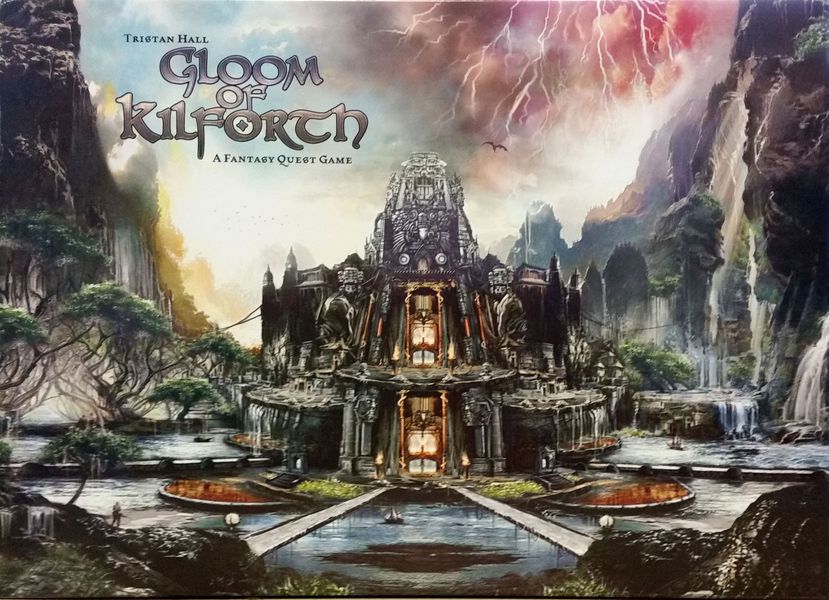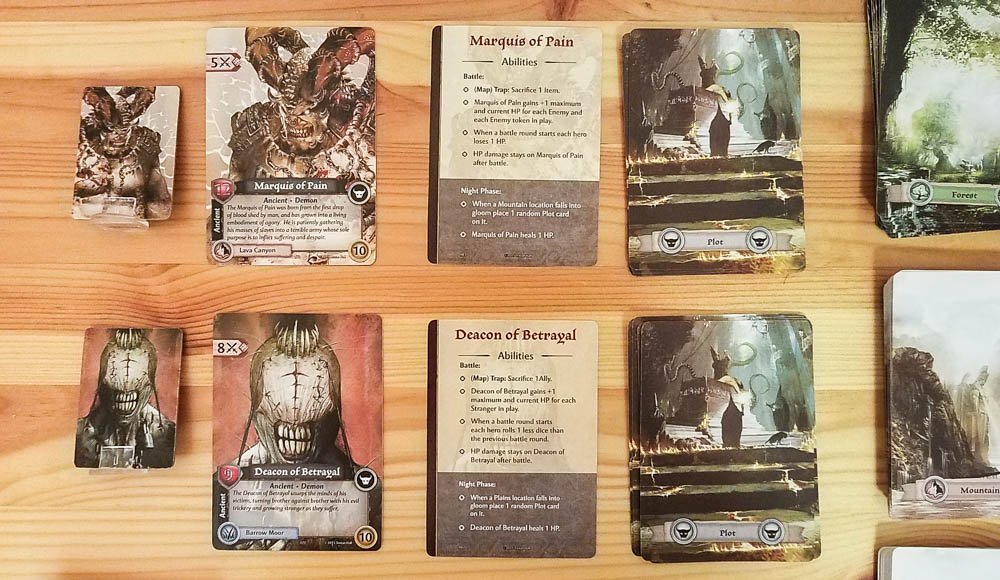Gloom of Kilforth Review
Year: 2017 | Players: 1-4 | Minutes: 60+ | Ages: 13+
This Gloom of Kilforth review was made after playing the game seven times. We were sent a copy of this game by the publisher in exchange for an honest review.
What is Gloom of Kilforth?
Gloom of Kilforth is a fantasy card game in which you play as heroes who are attempting to complete personal quests and defeat evil villains before a deadly gloom consumes the land. The game can be played solo, cooperatively, or competitively.
Gloom of Kilforth was designed by Tristan Hall and is published by Hall or Nothing Productions.
Rules Overview
Regardless of game mode, in Gloom of Kilforth you’re attempting to complete your hero’s saga and defeat the Ancient(s). Just about every card in the game has keywords on it, and you’ll be looking to collect the keywords that you need to complete each chapter of your saga by traveling around Kilforth and taking on encounters.
You’ll create your hero at the beginning of the game by grabbing a race and a class card, which gives them a unique combination of skills. Throughout the game you’ll be using those skills – Fight, Study, Sneak, and Influence – to take on the encounters that you run into.
There are 25 locations (in a 5×5 grid) that you can travel to on your adventure. 24 of those locations are one of four different terrain types – Mountain, Badlands, Plains, and Forest – and the 25th location, Sprawl City, is your home base and is located in the middle of the kingdom.
Rounds are broken up into Dawn, Daylight, and Night phases. During the Dawn phase, you’ll get your action points back (equal to your current health) and any heroes that were defeated show back up in Sprawl City. You’ll take actions during the Daylight phase, which include moving, searching locations, buying cards at the market, resting, and playing cards from your hand as assets to give your hero new abilities. A Night card is drawn during the Night phase, putting one location into “gloom” (flipping it) and possibly activating one of the Ancient’s plot card abilities.
Like many other games of this type, you’ll be performing a lot of tests to see whether you successfully defeated an encounter or not. Your stats for your skills usually tell you how many dice you’ll roll during those types of tests. For example, if you want to fight an enemy and you have a total Fight value of 4, you’ll roll four dice and you’ll try to get enough successes (fives and sixes) to defeat the enemy. Once per day, you can add a success to any test by discarding a rumor or by using a Fate token.
When you move to any location, you’ll draw an encounter card matching its terrain type and will have to deal with whatever type of encounter it is. Encounters come in five types: Enemies, Strangers, Places, Quests, and Events. You’ll gain rewards every time you defeat encounters, such as gold, adding the card to your hand as a rumor, or drawing a specific type of reward card.
Your hero’s saga is broken up into four chapters and a finale, each with keywords that you’ll need to find to advance through the saga. Besides events, every encounter card will have keywords (Villain, Forest, Stranger, etc.), so you’ll have an idea of where you should go to find what you need.
Cards in your hand are considered “rumors” and they become “assets” when they’re played on the table next to your hero. Assets give your hero new stat bonuses and/or special abilities. Rumors and assets can both be used to complete your saga’s chapters, but you have to discard any rumors that you use in this way.
Once you’ve completed your saga, your Ancient will show up in Kilforth. Fighting Ancients is similar to fighting any of the other enemies in the game, but you have to fight to the death once you’ve committed to doing battle with one. Ancients have abilities that they’ll use each round of the fight and they’ll gain extra abilities from any Plot cards you didn’t clear off of the board during your adventure.
You’ll win the solo and co-op games if you complete your saga(s) and defeat the Ancient(s). You’ll lose if all of the heroes die or if you haven’t won by the end of the 25th day/round. You’ll win the competitive game if you defeat the Ancient or, if no one has defeated the Ancient by the end of the 25th day, you have the highest gold and asset value total.
[the_ad_group id=”1052″]
Pros and Cons
Pros
- The set collection aspect of Gloom of Kilforth is what really sets it apart from other fantasy adventure games that I’ve played. The quests give you clear goals by listing the types of cards you need to find to progress, which works thematically and it gives the game a nice flow.
- The saga advancement / leveling system does make you feel like you’re progressing through an adventure and becoming a more powerful hero. Completing the fourth chapter of the saga is especially cool because you’ll usually either be getting your most powerful skill or gaining the ability to use your best attribute as your fight attribute (great against the Ancients).
- I love the way rumors and assets work. Either can be used to complete your quests, but you lose the rumors, which can be a big deal. It gives you a few extra interesting decisions to make since you have to decide what’s worth keeping with you throughout your adventure and what’s okay to discard to advance in your saga.
- This absolutely does feel like an adventure game. The game does a good job of making it feel like time is passing by as you’re moving from location to location, fighting off or evading enemies, searching for what you need for your quests, and seeing the gloom spread across the land.
- It also has a ton of replayability. The map is always different, the terrain cards are randomized, you’ll have different heroes and sagas, and, of course, the dice. All of that gives you a different adventure to play through every time this hits the table.
- Gloom of Kilforth has some of the best card art that I’ve seen. Ania Kryczkowska did an amazing job of bringing this fantasy world to life on all of these cards. Expect it to show up on this list soon.
- I like that the number of actions you get each round is directly tied to your health. That forces you to really care about the choices you make for your character. Sometimes you will take chances, but you’ll learn quickly how much of a drag it is to lose actions when you take damage in a fight.
- I also like that you take one turn at a time each round in the co-op and competitive modes. Turns can be a bit long, especially when someone gets into a fight, but the downtime isn’t too bad since you can plan out your next turn as the other players are taking theirs.
- It’s really cool that you can choose from multiple reward options when you defeat encounters. Sometimes you want the gold, but other times it’s better to take a chance and draw a token from the Loot bag. It’s nice having that extra bit of control.
- Gloom of Kilforth is a surprisingly easy game to get into. One person will have to get through the rulebook, but it’s an easy game to teach and learn. I actually taught this to a non-gamer and she knew how pretty much everything worked after only a couple of rounds.
Cons
- There are cooperative actions in Gloom of Kilforth, but for the most part you’re off doing your own thing, which I found pretty disappointing in my first few games. There’s a higher chance of cooperation in three and four-player games since you’re more likely to be around one or more other heroes, but even in those games you can usually complete your saga without needing to interact with other heroes.
- If the dice don’t like you, you could have a bad experience with this one. This can be a big problem early on when you don’t have much health and a limited amount of dice. Fate can help, but only in those situations where you need one more success.
- The four Ancients all feel pretty similar to me, even when they use their plot cards in battle. These guys are supposed to be extremely powerful, so I was hoping they’d have some cool abilities that made sense thematically. This isn’t too big of a deal, though, since this game is really all about the journey you go on to make it to that final boss.
- You can get stuck at locations searching for specific types of cards that you need. That’s not as big of a problem when playing solo, but in the other modes it doesn’t feel great when you’re stuck searching while everyone else is moving forward with their quests.
- There are 11 decks of cards to shuffle, so setup can take a minute.
Final Thoughts
I think Gloom of Kilforth is fantastic… as a solo game. I’d classify it as a solo game that you can also play cooperatively or competitively. I’m not saying that the co-op mode is bad, but just don’t expect there to be a ton of player interaction or cool combos you can pull off together. If that doesn’t bother you, chances are you’ll also enjoy the co-op mode.
I think people who are open to role playing it a bit will get more out of Gloom of Kilforth than anyone else, but fans of set collection games can also have some fun with this one. After our first few games, my group started playing it as more of a straightforward set collection game without getting too into the story and we still had a blast.
So yeah, I think Gloom of Kilforth is pretty great. I’m not much of a solo gamer, but I had so much fun in my “tester” solo game that I played it a couple more times solo and had a really good time with it. However, I don’t think I’ll be getting it to the table too many more times as a co-op since there are a bunch of other fantasy card games – Dragonfire, Heroes of Terrinoth, and Direwild are some examples – that have much more player interaction.
Gloom of Kilforth Links
BGG | Amazon | Miniature Market
Thanks for taking the time to read our Gloom of Kilforth review!
To stay updated on all things cooperative board games, follow us on Twitter, Facebook, or via RSS.




